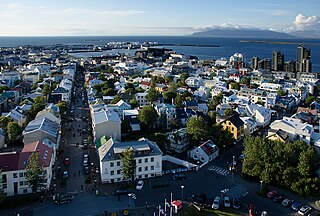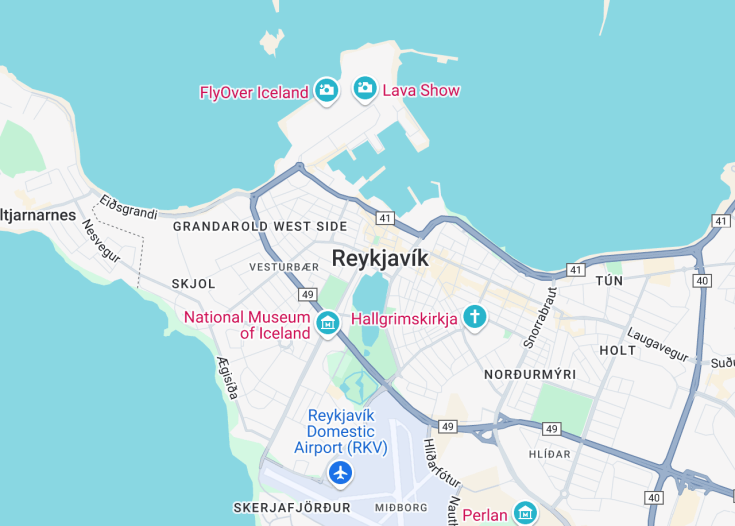Reykjavik, the northernmost capital of the world, blends natural beauty with clean, modern aesthetics. This city rests on the shores of Iceland, offering visitors stunning views of the sea and nearby mountains. Its distinct charm comes from a combination of cultural wealth, historical depth, and its residents’ warm hospitality. Reykjavik is famous for its vibrant arts scene, colorful buildings, geothermal pools, and a unique blend of conventional and contemporary cuisines that captivate travelers seeking both tranquility and adventure.
Before visiting Reykjavik, ensure to pack both warm and waterproof clothing. The weather can change swiftly, making layers essential for comfortable exploration.
If in Reykjavik during the winter, don’t miss the chance to view the Northern Lights. This spectacular natural phenomenon is most visible between September and April.
Top things to do & see in Reykjavik
Select the following sights and activities to discover best tickets and tours available in Reykjavik.
Reykjavik: A Gateway to Natural Wonders
| Country | Iceland |
| Time in Reykjavik | GMT-0 |
| Language spoken | Icelandic |
| Population | 131,136 (Statistics Iceland, 2023) |
| Currency | Icelandic króna (ISK, kr) |
| Airports |
|
Reykjavik, the capital and largest city of Iceland, serves as a central point of convergence for both cultural and geological exploration in the country. Situated on the southern shore of Faxa Bay, the city is known for its picturesque landscape, surrounded by mountains and the North Atlantic Ocean. Reykjavik is not just a city but a reflection of Iceland’s rich Nordic heritage, fused with contemporary advancements.
Its history spans back to the settlement by Norsemen in the AD 870, making it one of the first established cities in what would become a uniquely unified country. Reykjavik became the heart of Iceland’s economic, governmental, and cultural life, growing exponentially from a small trade town to a sophisticated urban area driven by tourism, fishing, and geothermal energy.
Home to cultural highlights such as the striking Hallgrímskirkja church and the buzzing Harpa Concert Hall, the city also offers diverse international dining scenes and vibrant nightlife. Moreover, Reykjavik is a hub for those seeking adventures in the vast, unspoiled landscapes of Iceland. From here, visitors can embark on journeys to see volcanoes, glaciers, geysers, and hot springs, or witness the spectacular Northern Lights during winter nights.
The city’s commitment to sustainability is evident in its reliance on geothermal heating and ambitious goals for carbon neutrality. This blend of natural beauty, rich history, and environmental consciousness makes Reykjavik a standout destination for travellers worldwide, keen on experiencing a unique blend of culture and nature.
Where is Reykjavik?
Located in southwest Iceland, Reykjavik sits on the coast of the country, offering views of the Atlantic Ocean and nearby mountain ranges.
Distances:
| Route | Distance by car | Time by car |
|---|---|---|
| Akranes to Reykjavik | 29 mi (47 km) | 50 min |
| Selfoss to Reykjavik | 36 mi (58 km) | 52 min |
| Keflavik to Reykjavik | 31 mi (50 km) | 45 min |
What is Reykjavik famous for?
Reykjavik is renowned for its stunning natural scenery, rich Viking history, and as a premier destination to view the Aurora Borealis. The city is also celebrated for its innovative use of geothermal energy.
History
874-1262: Settlement and Early History
Reykjavik, the capital city of Iceland, is said to have been first settled by Ingólfur Arnarson in the year 874. According to the Icelandic sagas—primarily the Landnámabók or the Book of Settlement—Arnarson was a Norse chieftain from Norway fleeing conflict. He threw his high seat pillars (a Norse chieftain’s ceremonial throne parts) into the sea, vowing to settle wherever they landed. They were found in a smoky bay, giving Reykjavik its name, which translates to “Smokey Bay,” referring to the steam from nearby hot springs. During this era, Iceland established one of the world’s first parliaments, the Alþingi, in 930, marking a significant epoch in the governance of the land.
1262-1918: Growth under Norwegian and Danish Rule
In 1262, Iceland entered into the Old Covenant, establishing a union with the Norwegian monarchy and later coming under Danish control in the 14th century. Through these centuries, Reykjavik remained a modest fishing village and trading post. Despite its peripheral role in European geopolitics, it played a central part in the trade networks between North Atlantic and mainland Europe, particularly in the export of wool and other goods. The Danish influence was evident in the urban planning and development of structures such as the Cathedral and the Alþingi building.
1918-1944: Towards Independence
Following the dissolution of the union with Denmark in 1918, Iceland became a sovereign state, the Kingdom of Iceland, in personal union with Denmark. Reykjavik began to emerge as a proper city, with increased urban development. It was during this period that Iceland progressively moved towards full independence, which was accelerated by World War II. The city was strategically important during the war, leading to significant British and later American military presence, which influenced both the economy and culture.
1944-Present: Independent Iceland and Modern Reykjavik
Reykjavik’s significance sprang forth fully after Iceland’s declaration of independence in 1944, becoming the capital of the newly established republic. The latter half of the 20th century saw rapid economic growth, urban expansion, and the establishment of comprehensive welfare systems. Modern-day Reykjavik is known for its vibrant cultural scene, robust environmental policies, and as a leader in green energy utilization, primarily geothermal energy. It remains a focal point of Icelandic identity and a primary gateway to the country’s numerous natural wonders.
Visit Reykjavik
What to see and do in Reykjavik, Iceland
Reykjavik offers a unique blend of natural beauty and cultural experiences. Visitors can explore:
- The National Museum of Iceland, which offers insights into Icelandic cultural history.
- Hallgrímskirkja, a stunning church that provides panoramic views of the city.
- The Sun Voyager, a striking steel sculpture along the scenic waterfront.
- Harpa Concert Hall and Conference Centre, known for its distinctive glass façade.
- The geothermal Blue Lagoon spa, located just outside the city.
The city also serves as a starting point for various excursions into the Icelandic wilderness, including the Golden Circle route, which features Geysir, Gullfoss Waterfall, and Þingvellir National Park.
Annual Events in Reykjavik
Reykjavik hosts a variety of events throughout the year, such as:
- The Reykjavik Arts Festival in May, showcasing local and international artists.
- Iceland Airwaves, a renowned music festival occurring every November.
- The Winter Lights Festival in February, which illuminates the city during the dark winter months.
These events highlight the city’s vibrant cultural life and offer visitors a chance to experience Icelandic hospitality.
Best time to visit Reykjavik
The ideal time to visit Reykjavik is during the summer months, from June to August, when the weather is milder and days are longest. This period offers the best conditions for exploring the city’s outdoor attractions and natural surroundings. However, those interested in viewing the Northern Lights should consider visiting from September to March, when the phenomenon is most visible.
is Reykjavik worth visiting?
Reykjavik is unquestionably worth visiting for its unique combination of stunning natural scenery, rich cultural history, and modern Nordic lifestyle. As the cultural and economic heart of Iceland, it offers an array of activities and sites that cater to both nature lovers and culture enthusiasts alike. Whether it’s exploring the city’s museums and galleries, relaxing in geothermal spas, or using it as a base to discover more of Iceland’s dramatic landscapes, Reykjavik promises a memorable experience.













